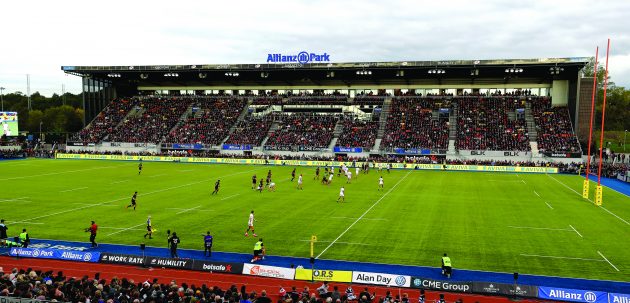The debate over whether artificial pitches are a good or a bad thing has been reignited after Northampton Saints scrum-half Alex Mitchell posted a gruesome image of bad grazes he sustained playing on an artificial pitch in the last round of Gallagher Premiership action.
Several team-mates came out in support, with images of their own, including Fraser Dingwall, Jamie Gibson and former Saint James Wilson.
Say No to these 4G pitches @theRPA pic.twitter.com/Qirb89ChIh
— Alex Mitchell (@alexmitchell97) March 4, 2019
But there are those who believe that artificial turf is a cost-effective way of ensuring a ground is playable more often and that offers a durable solution for clubs who want to offer a field to their community regularly.
Related: Should rugby have an orange card?
Back in our August 2018 issue of the magazine, we had a Face-Off on this very subject. Below you will see two different arguments on the value of artificial surfaces…

LUKE EDWARDS
Sports Systems Development Manager at SIS Pitches
As a World Rugby Preferred Turf Producer, SIS Pitches have worked with clubs and teams across all levels, including Saracens and Newcastle.
There are many benefits of installing an artificial pitch. The surface will perform consistently throughout the entire season; traction, shock absorption and head impact criterion will be the same all year, whatever the weather. The increased playing hours mean teams are able to maximise the use of their facility, both for training and in matches.
The level of specialist maintenance is nowhere near the same as required for maintaining perfect natural grass.
We don’t believe artificial pitches cause a higher rate of injury. A 2016-17 study by the RFU, Premiership Rugby and RPA noted that when combining data from four seasons, neither injury incidence nor severity differ between artificial and natural surfaces. But risk will keep being monitored.
 ED SLATER
ED SLATER
Gloucester second-row
At the top level I feel artificial pitches are a hindrance. I can see the benefit in lower leagues, particularly during bad weather, but they don’t train or play on them at the same intensity.
My main concern is how stiff the body feels after playing on an artificial pitch. I feel aches in my hips and back a lot more than if I’ve played on grass. It’s an indicator to me there’s more stress on the body.
I’ve spoken to props whose objective on a plastic pitch is to minimise foot movement as there’s not as much give. Players are changing their game to minimise the risk of injury.
I understand the business advantages of 4G pitches, but from a performance point of view it feels inconsistent. You go from good grass surfaces at Exeter or Northampton, to 4G at Saracens, which is slightly different to the 4G at Worcester.
We need to be more consistent. Right now, the surfaces are so different, it may affect the standard of rugby.
This first appeared in the August 2018 issue of Rugby World.





